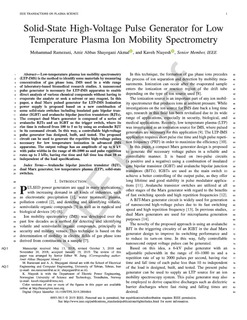| dc.contributor.author | Ramezani, Mohammad | |
| dc.contributor.author | Shayegani Akmal, Amir Abbas | |
| dc.contributor.author | Niayesh, Kaveh | |
| dc.date.accessioned | 2020-01-15T09:52:38Z | |
| dc.date.available | 2020-01-15T09:52:38Z | |
| dc.date.created | 2019-03-26T12:01:33Z | |
| dc.date.issued | 2019 | |
| dc.identifier.citation | IEEE Transactions on Plasma Science. 2019, 47 (3), 1629-1636. | nb_NO |
| dc.identifier.issn | 0093-3813 | |
| dc.identifier.uri | http://hdl.handle.net/11250/2636363 | |
| dc.description.abstract | Low-temperature plasma ion mobility spectrometry (LTP-IMS) is the method to identify some materials by measuring concentration of gas phase ions. IMS used in a wide range of laboratory-based biomedical research studies. A nanosecond pulse generator is necessary for LTP-IMS apparatus to enable direct analysis of various chemical compounds without having to evaporate the analyte or seek a solvent or any reagent. In this paper, a dual Marx pulsed generator for LTP-IMS Ionization power supply is proposed based on a new combination of some solid-state switches including insulated gate bipolar transistor (IGBT) and avalanche bipolar junction transistors (BJTs). The compact dual Marx generator is composed of a series of avalanche BJTs and an IGBT as the trigger switch, where its rise time is reduced from 100 to 5 ns by using an avalanche BJT in its command circuit. In this way, a controllable high-voltage pulse generator has designed, built, and tested. The proposed circuit can be used to generate the repetitive high-voltage pulses necessary for low temperature ionization in advanced IMS apparatus. The output voltage has an amplitude of up to 6 kV with pulse widths in the range of 40-1000 ns and pulse repetition rates up to 2 kHz, having rise time and fall time less than 10 ns independent of the load specifications. | nb_NO |
| dc.language.iso | eng | nb_NO |
| dc.publisher | Institute of Electrical and Electronics Engineers (IEEE) | nb_NO |
| dc.title | Solid-State High-Voltage Pulse Generator for Low Temperature Plasma Ion Mobility Spectrometry | nb_NO |
| dc.type | Journal article | nb_NO |
| dc.type | Peer reviewed | nb_NO |
| dc.description.version | acceptedVersion | nb_NO |
| dc.source.pagenumber | 1629-1636 | nb_NO |
| dc.source.volume | 47 | nb_NO |
| dc.source.journal | IEEE Transactions on Plasma Science | nb_NO |
| dc.source.issue | 3 | nb_NO |
| dc.identifier.doi | 10.1109/TPS.2019.2894844 | |
| dc.identifier.cristin | 1687788 | |
| dc.description.localcode | © 2019 IEEE. Personal use of this material is permitted. Permission from IEEE must be obtained for all other uses, in any current or future media, including reprinting/republishing this material for advertising or promotional purposes, creating new collective works, for resale or redistribution to servers or lists, or reuse of any copyrighted component of this work in other works. | nb_NO |
| cristin.unitcode | 194,63,20,0 | |
| cristin.unitname | Institutt for elkraftteknikk | |
| cristin.ispublished | true | |
| cristin.fulltext | postprint | |
| cristin.qualitycode | 1 | |
